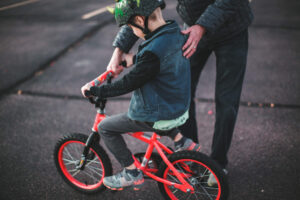 Learning how to ride a bike is an important milestone for many children. Some individuals can learn the skill as young as 4-years-old! However, as with other developmental milestones, it is important to take cues from your child. In order to be successful, children must have the balance, coordination, leg strength, and the ability to follow directions. Once your child has these physical traits and indicates their willingness to learn, our step-by-step approach is here to help.
Learning how to ride a bike is an important milestone for many children. Some individuals can learn the skill as young as 4-years-old! However, as with other developmental milestones, it is important to take cues from your child. In order to be successful, children must have the balance, coordination, leg strength, and the ability to follow directions. Once your child has these physical traits and indicates their willingness to learn, our step-by-step approach is here to help.
Signs Your Child is Ready to Ride a Bike
The timing is also dependent on the child’s mental development and comfort level. Have they indicated their readiness to learn? Do you feel they are mature enough? Another factor that can influence when a child wants to learn to ride is if they see their siblings and friends riding two-wheeled bikes. Parents should avoid pressuring children to learn how to ride a bike. He or she will likely get frustrated, hindering the process. Keep it fun!
Purchase the Right Equipment
Depending on your child’s height, the right-sized set of wheels is likely 14 or 16 inches. His or her feet should be able to touch the ground with straight legs when they’re sitting on the seat. Their leg should also be able to swing over the rear tire to sit down without any assistance. Do not purchase a larger bicycle and hope your child will grow into it. A larger bicycle will be harder for children to learn how to navigate.
Your child should wear a helmet every time they ride their bike, even if it’s just down the street. Make sure it fits properly! The helmet must be secured tightly in order to avoid rocking back and forth on the head. Parents should consider purchasing gloves, elbow and shin guards, knee pads and closed-toe shoes with no shoelaces for early riders.
Learning to Ride a Bike without Pedals
Once your child is ready to learn how to ride a bike, it’s best to go somewhere that is quiet and has a flat surface. Children should avoid learning on grass because they can’t obtain the necessary speed to learn how to coast and glide. There is also more resistance, forcing them to push themselves harder.
First, your child should practice getting on and off the bike. It’s important that they get comfortable before proceeding to the next step, which is learning how to scoot and glide on the bicycle. As they’re walking back and forth across the practice area, encourage them to look forward so they remain upright. Once they’ve mastered the ability to scoot and glide on the bike, they can move onto turning and steering. Make it fun! You can start with an easy game such as “follow the leader.” Parents can get on their bike and have their child follow them.
Add the Pedals
Once your child has become familiar with the bike, you can put on the pedals. To keep your child steady on the seat, hold onto their hips or shoulder. Resist the urge to hold onto the handlebars. As your child presses their foot on the pedal, keep your hand on their body to make sure they stay upright. Keep the rides short and sweet, remembering to take breaks as necessary. They might have trouble at first but with some patience and encouragement, your child will be on their way to success in no time!
Practice Makes Perfect
Congratulations! Your child has successfully learned how to ride a bicycle. This is a significant milestone in your son or daughter’s life and not only that, a wonderful memory for parents and children to share together. Once your child has learned to safely ride, he or she can take off with the other neighborhood children, under your supervision. For parents that are unable to watch them, our nanny services are here to help! For more information on how an after-school or part-time nanny can help your family, please contact us!
